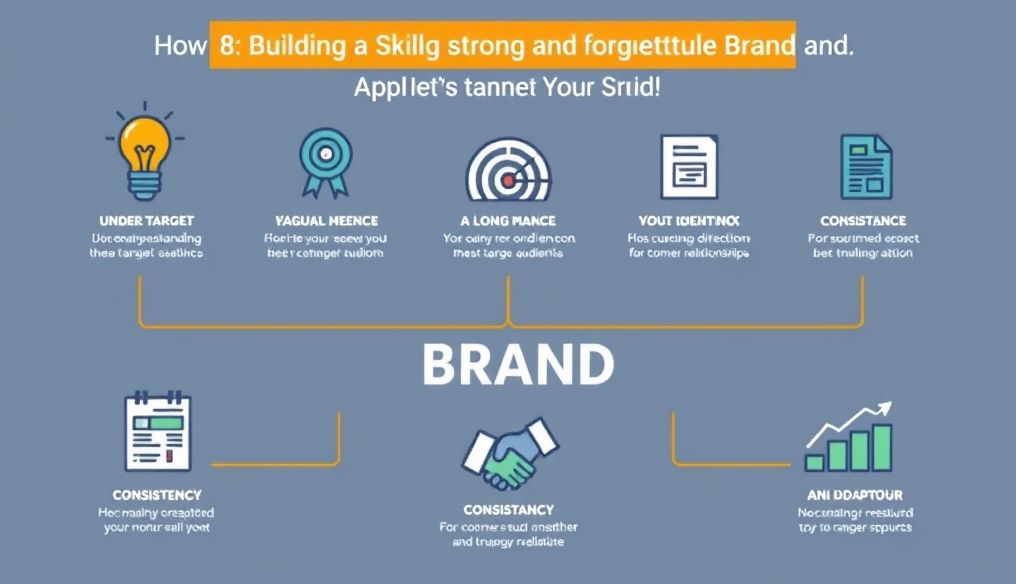How Do You Build a Strong and Unforgettable Brand in Today's Competitive Landscape?
In today's world, a strong brand is more than just a logo or a catchy name; it's a complete identity that reflects your values and message, creating an emotional connection with your audience. Building an unforgettable brand requires a solid strategy and continuous effort. This article will explore the essential steps to building a strong and distinctive brand.
1. Understanding Your Brand Essence: Who Are You and What Do You Stand For?
Before starting any marketing efforts, you must define your brand essence. This includes identifying:
- Vision: What is your ultimate goal? What do you aspire your brand to achieve in the future?
- Mission: What value do you provide to your customers? What problem do you solve?
- Values: What principles guide your work? What beliefs do you hold?
- Personality: If your brand were a person, what would they be like? Would they be friendly and fun, or serious and reliable?
Example: Nike. Their vision is "To bring inspiration and innovation to every athlete in the world." Their mission is "To bring inspiration and innovation to every athlete." Their values include innovation, performance, and inspiration. Their personality is an ambitious and inspiring athlete.
2. Identifying Your Target Audience: Who Are You Trying to Reach?
Knowing your target audience is crucial. You must understand their needs, desires, and challenges. You can do this through:
- Conducting Research: Surveys, focus groups, demographic data analysis.
- Creating Buyer Personas: Detailed representation of your ideal customers.
- Analyzing Competitors: Who are the customers your competitors are targeting?
Example: Starbucks. Their target audience is young professionals who are looking for a comfortable place to meet friends or work, and who appreciate quality and convenience.
3. Designing a Distinctive Visual Identity: Logo, Colors, and Fonts
Visual identity is how the world sees your brand. It should be attractive, consistent, and reflect your brand essence. Key elements of visual identity include:
- Logo: A simple and memorable symbol that represents your brand.
- Colors: Choose colors that evoke the emotions you want to associate with your brand.
- Fonts: Use fonts that reflect your brand's personality.
- Images: Use images that match your brand and appeal to your target audience.
Example: Coca-Cola. Their logo is simple and distinctive, their red and white colors evoke feelings of excitement and happiness, and their classic fonts reflect their long history.
4. Creating Valuable Content: Share Stories That Inspire, Educate, and Entertain
Content is how you communicate with your audience. It should be valuable, useful, and entertaining. Types of content you can create include:
- Articles: Share useful information and practical tips.
- Blogs: Express your opinions and ideas on topics related to your brand.
- Videos: Create educational or entertaining videos.
- Images: Share attractive images that reflect your brand.
- Infographics: Present data and information in a visually easy-to-understand way.
- Case Studies: Share success stories of your customers.
Example: Red Bull. They publish sports and adventure content that appeals to their target audience of young people looking for excitement.
5. Building Strong Customer Relationships: Listen, Engage, and Be Present
Strong customer relationships are the foundation of a successful brand. You must listen to your customers, engage with them, and provide them with excellent customer service. Ways to build strong relationships include:
- Listening to Customer Feedback: Use social media and surveys to collect customer feedback.
- Responding to Customer Inquiries: Be quick to respond to customer inquiries and provide assistance.
- Providing Excellent Customer Service: Make the customer experience as positive as possible.
- Building a Community Around Your Brand: Encourage customers to connect with each other and share their experiences.
Example: Zappos. They are known for their excellent customer service and generous return policy, which has helped them build a loyal customer base.
6. Be Consistent in All Aspects of Your Brand: From Messaging to Experiences
Consistency is key to building a strong brand. Your messaging, visual image, and customer experience should be consistent across all channels. This means:
- Using the same logo, colors, and fonts in all marketing materials.
- Delivering the same message across all channels.
- Providing a consistent customer experience online and offline.
Example: Apple. They maintain a high level of consistency in the design of their products, stores, and marketing messages, creating a unified brand experience.
7. Adapt to Changes: Be Flexible and Innovative
The world is constantly changing, and your brand must adapt to these changes. Be flexible and innovative, and try new things. This includes:
- Monitoring Trends: Stay up to date with new trends in your industry.
- Experimenting with New Technologies: Use new technologies to improve the customer experience.
- Developing New Products and Services: Continue to develop new products and services that meet customer needs.
Example: Netflix. Started as a DVD rental service by mail, then transformed into an online video streaming service, and continues to adapt to changes in the entertainment industry.
8. Measure Results and Improve Performance: Use Data to Make Informed Decisions
You must measure the results of your marketing efforts and continuously improve performance. Use data to make informed decisions. This includes:
- Tracking Key Metrics: Track the number of visits to your website, conversion rate, customer acquisition cost, and customer satisfaction.
- Analyzing Data: Use data to identify strengths and weaknesses in your marketing strategy.
- Making Adjustments: Make the necessary adjustments to your marketing strategy to improve performance.
Example: Amazon. They use data to improve the customer experience, personalize offers, and develop new products and services.
In conclusion, building a strong and unforgettable brand requires commitment and continuous effort. By understanding your brand essence, identifying your target audience, designing a distinctive visual identity, creating valuable content, building strong customer relationships, being consistent in all aspects of your brand, adapting to changes, and measuring results and improving performance, you can build a brand that lasts.




